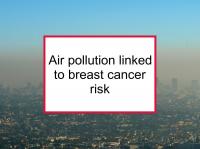Exposure to urban air pollution has been linked to increased risk of breast cancer in several studies. The incidence of breast cancer is reported to be higher in areas with greater levels of air pollution. Both the long-term time trend and geographic pattern of motor vehicle emissions have been positively associated with breast cancer rates.
Studies of the links between certain occupations and breast cancer risk have reported associations concerning exposures to certain chemicals that are also found in urban air. High levels of airborne particulates have also been found to be associated with reduced breast cancer survival. Now a large new study has reported a link between exposure to ambient air particulate matter and breast density.
Latest research finds link between particulates and breast density
The study referenced above was designed to investigate the association between breast density and exposure to particles up to 2.5 microns in diameter (PM2.5) and ozone. The study included women undergoing screening mammograms at imaging facilities within the Breast Cancer Surveillance Consortium during the period 2001 through 2009. A total of 279.967 women at least 40 years of age with known residential zip codes were included.
Mammographic breast density was determined using the American College of Radiology's Breast Imaging-Reporting and Data System (BI-RADS) classification system. Air particulate matter and ozone estimates for grids across the U.S. during the relevant years were obtained from the Environmental Protection Agency (EPA). These estimates were available for the majority of women (94%) for the year before the mammogram.
Women classified as having extremely dense breasts were found to have higher average PM2.5 and lower ozone exposures than women with non-dense fatty breasts (8.97 vs. 8.66 μg/m3 and 33.70 vs. 35.82 parts per billion, respectively). Further analysis showed that women with heterogeneously dense breasts were more likely to have higher exposure to PM2.5 than women with scattered fibroglandular breasts. Women with extremely dense were less likely to have higher levels of ozone exposure than women with scattered fibroglandular breasts.
The authors conclude that exposure to < 2.5 μm ambient air particulate matter and ozone could partially explain geographical variation in breast density. Further studies are needed to determine the causal nature of these associations, according to the authors.
Please see our article on breast density for more information.
